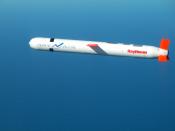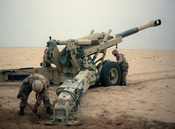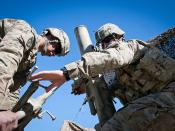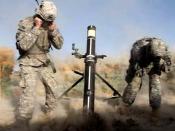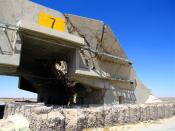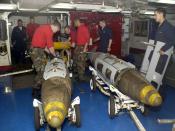In the Persian Gulf war of 1991, about 9% of the USA's ammunitions were smart weapons. Over the years, this technology has become greater, and by 1995 when the U.S. and its North Atlantic Treaty Organization allies undertook a three-week air campaign against the Serbs of Bosnia, 70% of the bombs were guided munitions. Wars no longer consist of people going out and dying on the battlefield, wars are consisted of people pushing buttons. Smart weapons came into the scene a few decades ago, but several advances have been made since then. A smart weapon is a bomb or missile that is guided by laser or GPS to hit a designated target. A smart weapon can fly up to 18 miles before ploughing it's way through 8 thick slabs of steel and then blowing away an area not 4 feet from the target. Pictures have been taken in Yugoslavia where an army barracks is seen to have been blown sky high, while surrounding buildings seem unscathed.
It can seem to cause major destruction and death in one area, but not even affect an area not 3 blocks away. A smart weapon can be fired from the air, a ship, or land. In a plane, usually a plane flies ahead to get the co-ordinates so the plane behind can set the smart weapons' laser to it. One major defect of a smart weapon is weather. A laser-guided weapon can be thrown totally off its target by smoke, fog, haze or clouds. Recently, in a small Serbian mining town called Aleksinac, a smart weapon missed its target and flattened 2 residential areas and killed as many as 20 civilians. When the weather is bad, the GPS or satellite-guided weapons are the ones to be relied on. These work by bouncing signals off satellites and back to the missile, where small wings can change the course of the missile. Weather does not affect them and they are generally more accurate. One problem with this is the price. A GPS or satellite-guided missile can cost up to a million dollars, or $50, 000 to upgrade from a normal missile. After almost 30 years, the pentagon is still using smart weapons for almost 100% of its strikes. Over the years, the technology of smart weapons has increased greatly, and I think it will continue to increase for years to come and while these are all big steps in humanity, there are no winners in a war.
